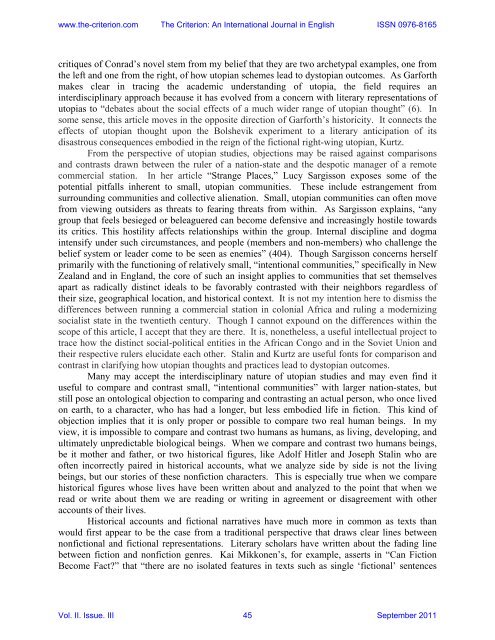Vol. II. Issue. III September 2011 - The Criterion: An International ...
Vol. II. Issue. III September 2011 - The Criterion: An International ...
Vol. II. Issue. III September 2011 - The Criterion: An International ...
You also want an ePaper? Increase the reach of your titles
YUMPU automatically turns print PDFs into web optimized ePapers that Google loves.
www.the-criterion.com <strong>The</strong> <strong>Criterion</strong>: <strong>An</strong> <strong>International</strong> Journal in English ISSN 0976-8165<br />
critiques of Conrad’s novel stem from my belief that they are two archetypal examples, one from<br />
the left and one from the right, of how utopian schemes lead to dystopian outcomes. As Garforth<br />
makes clear in tracing the academic understanding of utopia, the field requires an<br />
interdisciplinary approach because it has evolved from a concern with literary representations of<br />
utopias to “debates about the social effects of a much wider range of utopian thought” (6). In<br />
some sense, this article moves in the opposite direction of Garforth’s historicity. It connects the<br />
effects of utopian thought upon the Bolshevik experiment to a literary anticipation of its<br />
disastrous consequences embodied in the reign of the fictional right-wing utopian, Kurtz.<br />
From the perspective of utopian studies, objections may be raised against comparisons<br />
and contrasts drawn between the ruler of a nation-state and the despotic manager of a remote<br />
commercial station. In her article “Strange Places,” Lucy Sargisson exposes some of the<br />
potential pitfalls inherent to small, utopian communities. <strong>The</strong>se include estrangement from<br />
surrounding communities and collective alienation. Small, utopian communities can often move<br />
from viewing outsiders as threats to fearing threats from within. As Sargisson explains, “any<br />
group that feels besieged or beleaguered can become defensive and increasingly hostile towards<br />
its critics. This hostility affects relationships within the group. Internal discipline and dogma<br />
intensify under such circumstances, and people (members and non-members) who challenge the<br />
belief system or leader come to be seen as enemies” (404). Though Sargisson concerns herself<br />
primarily with the functioning of relatively small, “intentional communities,” specifically in New<br />
Zealand and in England, the core of such an insight applies to communities that set themselves<br />
apart as radically distinct ideals to be favorably contrasted with their neighbors regardless of<br />
their size, geographical location, and historical context. It is not my intention here to dismiss the<br />
differences between running a commercial station in colonial Africa and ruling a modernizing<br />
socialist state in the twentieth century. Though I cannot expound on the differences within the<br />
scope of this article, I accept that they are there. It is, nonetheless, a useful intellectual project to<br />
trace how the distinct social-political entities in the African Congo and in the Soviet Union and<br />
their respective rulers elucidate each other. Stalin and Kurtz are useful fonts for comparison and<br />
contrast in clarifying how utopian thoughts and practices lead to dystopian outcomes.<br />
Many may accept the interdisciplinary nature of utopian studies and may even find it<br />
useful to compare and contrast small, “intentional communities” with larger nation-states, but<br />
still pose an ontological objection to comparing and contrasting an actual person, who once lived<br />
on earth, to a character, who has had a longer, but less embodied life in fiction. This kind of<br />
objection implies that it is only proper or possible to compare two real human beings. In my<br />
view, it is impossible to compare and contrast two humans as humans, as living, developing, and<br />
ultimately unpredictable biological beings. When we compare and contrast two humans beings,<br />
be it mother and father, or two historical figures, like Adolf Hitler and Joseph Stalin who are<br />
often incorrectly paired in historical accounts, what we analyze side by side is not the living<br />
beings, but our stories of these nonfiction characters. This is especially true when we compare<br />
historical figures whose lives have been written about and analyzed to the point that when we<br />
read or write about them we are reading or writing in agreement or disagreement with other<br />
accounts of their lives.<br />
Historical accounts and fictional narratives have much more in common as texts than<br />
would first appear to be the case from a traditional perspective that draws clear lines between<br />
nonfictional and fictional representations. Literary scholars have written about the fading line<br />
between fiction and nonfiction genres. Kai Mikkonen’s, for example, asserts in “Can Fiction<br />
Become Fact?” that “there are no isolated features in texts such as single ‘fictional’ sentences<br />
<strong>Vol</strong>. <strong>II</strong>. <strong>Issue</strong>. <strong>II</strong>I 45 <strong>September</strong> <strong>2011</strong>
















